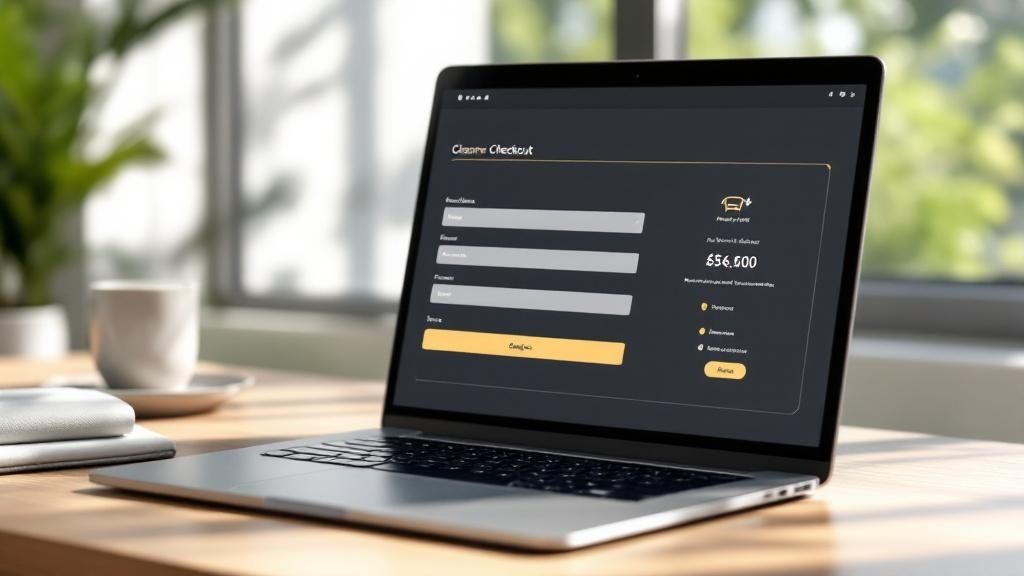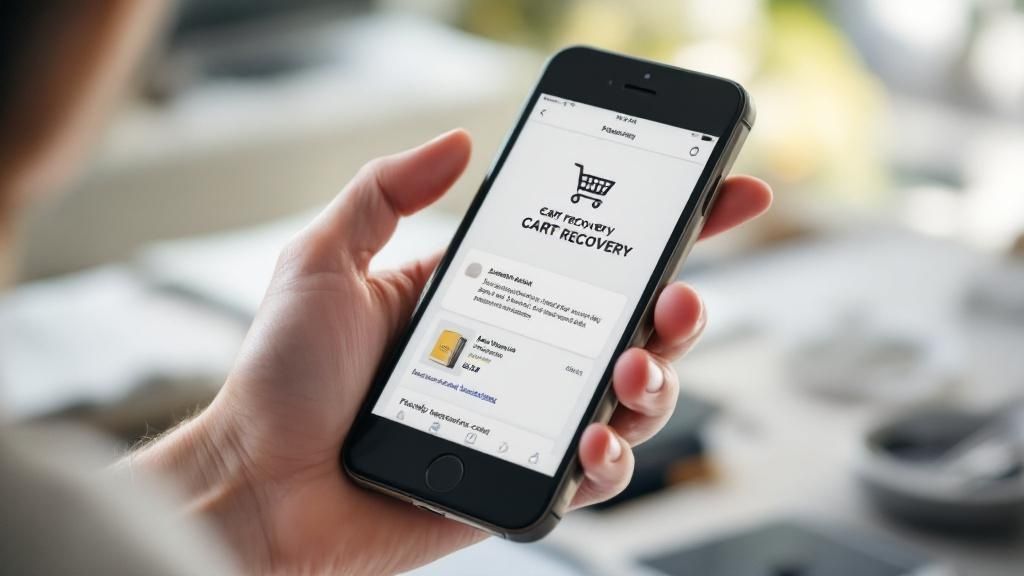To effectively reduce cart abandonment, you must understand the customer's mindset. An abandoned cart is more than a lost sale; it's direct feedback on your entire purchasing process. It's a customer pinpointing a friction point, showing you exactly what needs to be fixed.
Why Shoppers Really Ditch Their Carts

Before implementing solutions, you must accurately diagnose the problem. While every e-commerce store is unique, the reasons customers hesitate at the finish line often trace back to a few core frustrations that shatter trust or demand too much effort. Moving past generic lists to understand these real-world roadblocks is the first critical step.
This is not a minor issue. The global average cart abandonment rate now sits at a staggering 70.19%, and this figure has been climbing for nearly a decade.
This trend indicates a clear disconnect between shopper expectations and the reality of online checkout experiences. In regions like Europe and Asia, the rate can be even higher—sometimes topping 80%—often driven by high shipping fees and a lack of familiar payment methods.
Hidden Costs and Checkout Headaches
By far, the number one reason people abandon their carts is being ambushed by unexpected costs at the end of the process. Imagine a customer has mentally committed to paying $50 for your product. When they reach the final screen and see shipping and taxes suddenly increase the price to $65, it feels like a bait-and-switch. This isn't just a budget issue; it's an emotional one that instantly erodes trust.
Another significant factor is a checkout process that feels like a chore. In an age of one-click convenience, forcing someone to create an account or complete numerous fields is a recipe for abandonment. Every extra step and every unnecessary question dramatically increases the odds that a shopper will simply give up and leave.
An abandoned cart is rarely a rejection of the product. More often, it’s a rejection of the process required to buy it. Shifting your mindset from "selling" to "helping the customer buy" changes everything.
Addressing these core issues is the foundation of a successful strategy. When you fix them, you’re not just learning how to reduce cart abandonment; you're fundamentally improving the entire customer journey. This builds confidence and paves the way for turning first-time buyers into loyal fans. For a deeper dive, explore our guide on powerful customer retention strategies.
Crafting a Checkout That Actually Converts
A clunky, confusing checkout is the digital equivalent of a long, slow line at a physical store—the fastest way to kill a sale. Your goal is to make this final step feel so smooth and intuitive that the customer barely notices they're completing it. It’s all about stripping away friction and gently guiding them across the finish line.
One of the first decisions is the layout: will you opt for a single-page checkout or a multi-step process?
Single-Page vs. Multi-Step Checkout
Both approaches have distinct pros and cons, and the right choice often depends on what you're selling.
- Single-Page Checkout: This design consolidates all elements—shipping, billing, payment—onto one screen. It can feel exceptionally quick for straightforward purchases. The potential downside? A long, single page can appear overwhelming at first glance, sometimes causing hesitation before the user even begins.
- Multi-Step Checkout: This approach breaks the process into logical chunks, such as Shipping, then Payment, then Review. A visible progress bar is essential here. It informs customers of their position in the process and how close they are to completion, making the experience feel more manageable, especially for complex orders.
Keep It Simple, Seriously
Regardless of the structure you choose, several optimizations are non-negotiable for preventing last-minute sales loss. The most critical one is guest checkout.
Forcing someone to create an account is a massive roadblock. In fact, studies show it's the reason 24% of shoppers will ditch their cart. Let them purchase without the commitment; you can always invite them to create an account on the "thank you" page after the sale is complete.
Another crucial consideration is mobile performance. The data is sobering: cart abandonment rates on mobile devices can be as high as 85%. Users have less patience for slow pages and frustrating forms on a small screen. You can explore more of this data in this comprehensive cart abandonment report.
A customer who places an item in their cart has already decided they want your product. Don't let a poorly designed form talk them out of it. Every field you can remove and every click you can save gets you closer to a completed sale.
This is where smart features can make a world of difference. Implementing address autofill with a tool like the Google Places API or securely saving payment details for returning customers are no longer just nice-to-haves. These conveniences demonstrate respect for your customer's time and make it incredibly easy for them to return and buy again.
Earning Unbreakable Trust at Checkout
In e-commerce, trust is paramount. Your checkout page is where that trust is put to the ultimate test. It’s the final hurdle, and it’s surprisingly easy to lose a customer right before the finish line.
The quickest way to shatter trust is with surprise costs. When a customer is ready to buy and then gets hit with an unexpected shipping fee or tax calculation, it feels deceptive. This is the #1 reason people abandon carts. You're not just losing a sale; you're losing a potential long-term customer.
The solution is radical transparency. Don't wait for the final payment screen. Display a full cost summary, including estimated taxes and shipping, directly on the cart page itself. This single move respects your customer's intelligence and budget, eliminating the bait-and-switch feeling that kills conversions.
Showing Shoppers Your Site is Secure
Beyond transparent pricing, customers need to feel their data is safe. From their perspective, they're about to share sensitive financial information. If your site doesn't visually communicate security, they will hesitate, especially if they are a new customer.
This is all about visual reassurance. You must place trust signals exactly where their eyes will be when they're feeling most vulnerable—next to the credit card fields.
- Security Seals: While an SSL certificate is standard, don't assume shoppers know that. Displaying a familiar seal from a provider like Norton or McAfee visually confirms their connection is encrypted.
- Payment Logos: When you show logos for PayPal, Apple Pay, or even Klarna, you're doing more than just listing options. You're borrowing credibility from these massive, trusted brands.
- A Clear Return Policy: A prominent link to a simple, fair return policy at checkout is a powerful tool. It dramatically lowers the perceived risk for the buyer, assuring them they won't be stuck with something that isn't right.
A secure checkout is less about the backend code and more about the customer's feeling of safety. Every badge, logo, and clear policy is a small signal that tells them, "We've got your back." That's how you turn a hesitant browser into a confident buyer.
The final piece of the puzzle is offering a modern mix of payment options. Not everyone wants to use a credit card. By including digital wallets and Buy Now, Pay Later (BNPL) services, you meet customers where they are. You give them the control to pay in a way that feels comfortable and secure for them, which is a huge factor in closing the sale and reducing cart abandonment.
Winning the Battle on Mobile Devices
It’s no longer enough to have a website that simply shrinks to fit a phone screen. A staggering amount of online shopping now happens on smartphones, meaning your checkout process must be built for thumbs, not just adapted for smaller displays.
Consider your own experience: how frustrating is it to pinch and zoom just to tap a button? Every element—from form fields to navigation links—needs to be large, easily tappable, and logically spaced. This isn't just about aesthetics; it's about creating a smooth, frustration-free path to purchase.
Make it Fast, Make it Easy
Speed is everything on mobile. Users are often shopping on the go, with spotty connections and countless distractions. Every extra second your page takes to load is another reason for them to abandon the purchase.
Focus on convenience beyond the layout. The goal is to eliminate as much tedious typing as possible. Integrating digital wallets is a significant win here. Offering options like Apple Pay and Google Pay can turn a multi-step checkout into a single, secure tap or glance.
Another intelligent move is to leverage the phone's built-in hardware. Why make someone painstakingly type a 16-digit credit card number when they can just scan it with their camera? It's a small feature that makes a massive difference in the user experience.
- Offer Digital Wallets: Let customers breeze through checkout with one-tap solutions like Apple Pay, Google Pay, and PayPal, which pre-fill all their shipping and payment details.
- Use Camera Scanning: Implement a feature that allows users to securely scan their credit card to auto-populate the payment fields.
- Design for Thumbs: Ensure every button and link is large enough to be tapped easily without hitting the wrong thing.
This chart drives home how seemingly small tweaks, like offering a guest checkout, can have a massive impact on your sales and abandonment rates.

The data speaks for itself. Eliminating the friction from mandatory account creation is a direct and powerful way to reduce cart abandonment.
Key Mobile Checkout Optimizations
To truly excel on mobile, you need to implement features specifically designed for the platform. This table breaks down some of the most impactful optimizations you can make.
Ultimately, treating the mobile checkout as a unique experience—not just a shrunken desktop site—is how you win over modern customers.
A fast, intuitive, and secure mobile journey is your best strategy for turning on-the-go browsers into paying customers. By meeting them where they are, with the convenience they expect, you’ll see your conversion rates climb.
Smart Strategies to Get Those Abandoned Carts Back

An abandoned cart isn't a lost sale. It’s a warm lead—a customer who was inches from buying. With the right strategy, you can gently nudge a surprising number of them back to complete their purchase.
The most effective tool in your arsenal is the abandoned cart email sequence. The key is to sound helpful, not desperate. Your first email should be sent within an hour of abandonment and framed as a simple customer service check-in: "Did you run into any trouble checking out? We saved your cart for you."
If they don't convert, the follow-up is crucial.
Fine-Tuning Your Email Timing and Offers
Waiting approximately 24 hours for a second email often hits the sweet spot. This is your chance to create a little urgency. You could mention that an item in their cart is low in stock or showcase glowing customer reviews for the products they were considering. It’s about reminding them why they were interested in the first place.
Only if they still haven't returned should you introduce a stronger incentive. A third email, sent around the 72-hour mark, is the perfect time to introduce a compelling offer. This is especially true for high-value carts. A small discount or free shipping can be the final push they need.
Thinking Beyond the Inbox
While emails are effective, relying on them alone means leaving money on the table. A truly effective recovery plan uses multiple channels. For instance, running retargeting ads on social media or Google can keep your brand and the specific products they viewed top-of-mind. These visual reminders serve as a subtle nudge back to your store.
Your last line of defense? Exit-intent popups. Just as a visitor's cursor drifts towards the 'close' button, a well-timed popup can work magic. Offering an immediate, compelling deal—like 10% off their order or free shipping—can be the one thing that stops them from leaving and turns that almost-lost sale into a conversion.
Combining these recovery tactics is a cornerstone of a powerful sales funnel. To see how these strategies fit into a bigger picture, take a look at our guide on the 10 best digital marketing tips for ecommerce. When you start treating cart abandonment as an opportunity, you'll see a real impact on your bottom line.
How Industry and Location Shape Abandonment
Cart abandonment isn't a universal problem solvable with a single, generic fix. The reasons a customer leaves a luxury watch in their cart are entirely different from why someone might abandon an order for grocery delivery. To create strategies that truly move the needle, you must get specific.
Industries with expensive, high-consideration products naturally have more "window shoppers." This is why you see such high abandonment rates in sectors like home furnishings (78.65%), jewelry (81.68%), and telecommunications (79.16%). Customers are comparing prices, reading reviews, and taking their time before making a significant commitment.
Conversely, businesses built on repeat purchases, like groceries or pharmaceuticals, tend to have much lower rates, often between 50-57%. For them, the challenge isn't price hesitation; it’s about making the checkout process as fast and frictionless as possible.
Global Nuances in Shopper Behavior
Just as industries differ, so do shoppers around the world. What works for a customer in North America might be a dealbreaker for someone in Asia. Logistics, payment habits, and cultural expectations all play a massive role in why people abandon carts.
The real breakthrough in reducing cart abandonment comes when you stop applying generic fixes and start personalizing your approach based on what you sell and who you sell to. A localized strategy is a powerful competitive advantage.
The regional differences are striking. Some of the highest abandonment rates are found in the Middle East, Africa, Asia Pacific, and Latin America. These disparities often come down to very specific, local challenges:
- Limited shipping infrastructure
- Lack of preferred payment options (like cash-on-delivery)
- Unique consumer buying habits
You can dive deeper into these regional trends with the latest shopping cart abandonment data.
Once you understand why your specific audience is leaving—whether it's price, shipping headaches, or payment friction—you can start building a targeted solution. This is how you turn a regional weakness into a competitive edge. Of course, getting seen in the first place is just as important, a topic we explore in our guide on improving sales with e-commerce SEO.
Your Top Cart Abandonment Questions, Answered

As you work to tackle cart abandonment, a few key questions inevitably arise. Let's walk through the most common queries to provide clear, practical answers.
What’s a Good Cart Abandonment Rate?
While everyone seeks a magic number, the truth is, it varies. Although the global average sits around a staggering 70%, a "good" rate really depends on your specific industry and product type.
Top-tier e-commerce sites often achieve rates between 40% and 60%, which is an excellent benchmark.
Stop chasing a universal number. Your real goal should be to continuously improve your own baseline. Focus on incrementally lowering that rate, month after month.
How Quickly Should I Send a Recovery Email?
Timing is critical. The sweet spot for the first recovery email is within the first hour. This is quick enough that the purchase is still top-of-mind for the shopper, but not so fast that it feels intrusive or overly automated.
A proven sequence that performs well for many stores is to follow up at 24 hours and then again at 72 hours. Each message should have a slightly different angle—the first a simple reminder, the next perhaps highlighting product benefits or scarcity.
Should I Offer a Discount in Every Recovery Email?
This is a tempting trap that should be avoided. If you offer a discount in every abandoned cart email, you will train customers to game the system. They may begin abandoning carts intentionally to receive a coupon, which can erode your profit margins.
A smarter, more sustainable strategy is to tier your offers.
- Email 1: A friendly, no-pressure reminder.
- Email 2: If they haven't converted, consider offering free shipping. This is a powerful incentive that often feels more valuable than a small discount.
- Email 3: Reserve your best offers, like a percentage off, for high-value carts or as a final attempt to win them back.
Ready to turn those abandoned carts into completed sales? The team at Twelverays lives and breathes this stuff. We build data-backed strategies to smooth out your entire customer journey and boost conversions. Let's build a solution that drives measurable growth for your business.





